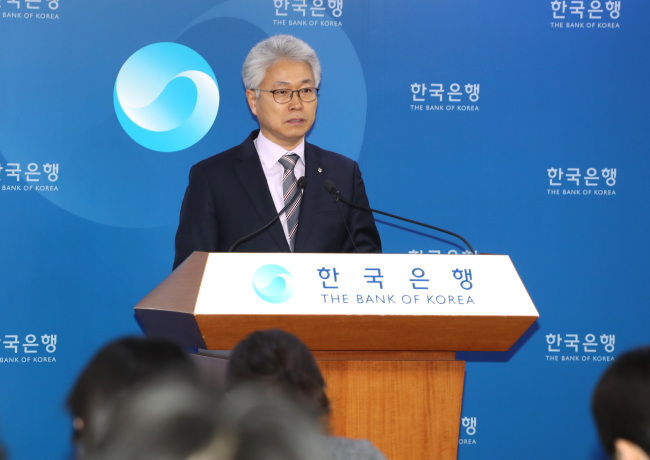Economy grows 2.7% in 2018, marks slowest on-year rise in 6 years: BOK
GNI likely to have surpassed $31,000 per capita last year for the first time
By Bae HyunjungPublished : Jan. 22, 2019 - 17:00
Last year, the South Korean economy marked the slowest on-year growth pace in six years, amid shrinking corporate investment and slowing exports, central bank data showed Tuesday.
Expanded government spending in the final quarter of the year was seen as having raised the annual figure to meet the government target level, while private sector remained sluggish, according to the bank.
The country’s economy grew 2.7 percent on-year in 2018, down from 3.1 percent in the previous year, according to the advance estimate released by the Bank of Korea.
Though this met the BOK’s earlier forecast, it fell short of the International Monetary Fund’s 2.8 percent forecast and also marked the slowest on-year growth since the 2.3 percent observed in 2012.
Of the total yearly growth, 1 percent was attained in the final quarter, rising 0.4 percentage point from the previous quarter on the back of expanded fiscal spending.
Government expenditure in the fourth quarter grew 3.1 percent from the previous quarter, recording the steepest on-quarter rate of increase in eight years and three months. Compared to a year earlier, the rate of increase stood at a 10-year high of 7.1 percent, indicating that the Seoul government pumped as much money into the economy as it had in the aftermath of the global financial crisis.
Expanded government spending in the final quarter of the year was seen as having raised the annual figure to meet the government target level, while private sector remained sluggish, according to the bank.
The country’s economy grew 2.7 percent on-year in 2018, down from 3.1 percent in the previous year, according to the advance estimate released by the Bank of Korea.
Though this met the BOK’s earlier forecast, it fell short of the International Monetary Fund’s 2.8 percent forecast and also marked the slowest on-year growth since the 2.3 percent observed in 2012.
Of the total yearly growth, 1 percent was attained in the final quarter, rising 0.4 percentage point from the previous quarter on the back of expanded fiscal spending.
Government expenditure in the fourth quarter grew 3.1 percent from the previous quarter, recording the steepest on-quarter rate of increase in eight years and three months. Compared to a year earlier, the rate of increase stood at a 10-year high of 7.1 percent, indicating that the Seoul government pumped as much money into the economy as it had in the aftermath of the global financial crisis.

“The government made pump-priming efforts during the final quarter to counter the slowdown in exports,” said Park Yang-su, director general of the economic statistics department at the BOK.
The most drastic increase in expenditure was observed in the production cost for public goods, such as water pipes and construction material, the BOK data showed.
“The social overhead capital sector saw a rise in government spending during the fourth quarter, as several local governments sped up pending construction projects after taking office in July.”
Meanwhile, the country’s gross national income is likely to have surpassed $31,000 per capita last year for the first time. In the previous year, the per capita income stood at $29,745, missing the $30,000 mark.
Despite supplementary actions by the government, concerns lingered, as corporate investment remained sluggish.
Construction investment shed 4 percent last year from a year earlier, marking the steepest on-year pace of decrease since the 2008 Asian financial crisis, while facility investment shrank to a nine-year low of 1.7 percent in the same period.
By industry, the manufacturing sector slowed down to 3.6 percent from 4.4 percent two years before, and the construction business dipped to a seven-year low of 4.2 percent.
By Bae Hyun-jung (tellme@heraldcorp.com)






![[From the Scene] Monks, Buddhists hail return of remains of Buddhas](http://res.heraldm.com/phpwas/restmb_idxmake.php?idx=644&simg=/content/image/2024/04/19/20240419050617_0.jpg&u=20240419175937)





![[Graphic News] French bulldog most popular breed in US, Maltese most popular in Korea](http://res.heraldm.com/phpwas/restmb_idxmake.php?idx=644&simg=/content/image/2024/04/18/20240418050864_0.gif&u=)


![[From the Scene] Monks, Buddhists hail return of remains of Buddhas](http://res.heraldm.com/phpwas/restmb_idxmake.php?idx=652&simg=/content/image/2024/04/19/20240419050617_0.jpg&u=20240419175937)

![[KH Explains] Hyundai's full hybrid edge to pay off amid slow transition to pure EVs](http://res.heraldm.com/phpwas/restmb_idxmake.php?idx=652&simg=/content/image/2024/04/18/20240418050645_0.jpg&u=20240419100350)

![[Today’s K-pop] Illit drops debut single remix](http://res.heraldm.com/phpwas/restmb_idxmake.php?idx=642&simg=/content/image/2024/04/19/20240419050612_0.jpg&u=)